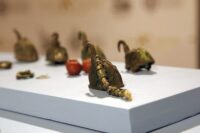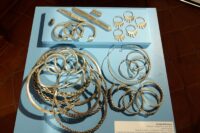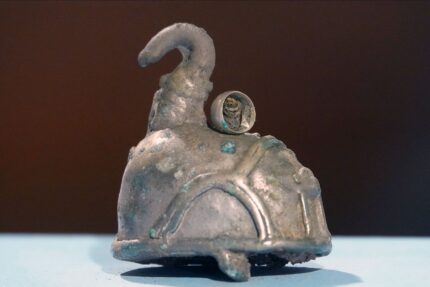 Two unique medieval hoards have been discovered in Russia this summer: a set of Volga-Finnish jewelry from the 6th century and a group jewelry and a bowl from the late 11th century or first half of the 12th. The former is the first hoard of Volga-Finnish women’s jewelry from the Migration Period ever discovered in the Suzdal district of western Russia. The latter is a hoard of 32 silver jewels including neck torques, bracelets and rings that predates the known settlements in the area.
Two unique medieval hoards have been discovered in Russia this summer: a set of Volga-Finnish jewelry from the 6th century and a group jewelry and a bowl from the late 11th century or first half of the 12th. The former is the first hoard of Volga-Finnish women’s jewelry from the Migration Period ever discovered in the Suzdal district of western Russia. The latter is a hoard of 32 silver jewels including neck torques, bracelets and rings that predates the known settlements in the area.
The Suzdal hoard was unearthed on the right bank of the Nerl-Klyazminskaya river. It is a set of jewelry from a traditional Volga Finn woman’s costume. The non-ferrous metal objects include fragments of a  headdress, three bracelets, an open-work brooch, more than 300 beads and a remarkable group of six hollow duck-shaped pendants that were once threaded on a leather cord decorated with metal beads. Waterfowl had religious significance to the Volga Finns and other Finno-Ugric cultures, as they were associated with their creation myths. There was also a metal bowl with a looping handle that is an extremely rare import from the Middle East and is older than the jewelry. It may have had ritual use.
headdress, three bracelets, an open-work brooch, more than 300 beads and a remarkable group of six hollow duck-shaped pendants that were once threaded on a leather cord decorated with metal beads. Waterfowl had religious significance to the Volga Finns and other Finno-Ugric cultures, as they were associated with their creation myths. There was also a metal bowl with a looping handle that is an extremely rare import from the Middle East and is older than the jewelry. It may have had ritual use.
According to manager Nikolai Makarov of the Russian Academy of Sciences’ Institute of Archaeology, “These are not just collected items: they are elements of a woman’s costume. The find lifts the veil over the ‘Finnish prehistory’ of the Suzdal Opolye, which is known today to historians and archaeologists mainly as one of the centers of ancient Russian culture. Further research of the objects of the treasure and the settlement will make it possible to understand how Opolye was developed in the period preceding the Slavic colonization.”
Archaeologists believe the ornaments were hidden in a box made of birch bark near the settlement’s center, but the motive for hiding the treasure remains unknown.
 The silver hoard was found on a forested slope near the village of Isady is northwestern Russia. The area has produced many a hoard — at least 17 documented ones — cached in the 13th century when the town of Ryazan became the first Russian city besieged by the Golden Horde forces of Batu Khan, Genghis’ grandson, in 1237. This one is earlier, however, and contains jewelry that is simpler in design and manufacture than the Ryazan treasures.
The silver hoard was found on a forested slope near the village of Isady is northwestern Russia. The area has produced many a hoard — at least 17 documented ones — cached in the 13th century when the town of Ryazan became the first Russian city besieged by the Golden Horde forces of Batu Khan, Genghis’ grandson, in 1237. This one is earlier, however, and contains jewelry that is simpler in design and manufacture than the Ryazan treasures.
It is not a single set like the Suzdal jewelry, but rather wealth accumulated over time and buried, likely for safety. The jewels had been buried in a  small container, now decayed. They include eight torques, 14 bracelets, 5 seven-rayed rings and several grivnas of the Novgorod type (triangular silver ingots). There are a variety of torque types, including twisted and braided ones, ones with hollow terminals and ones decorated with wolf’s tooth patterns. The bracelets are also varied in type (braided, knotted, smooth, rhomic ) and ornamented with varied motifs (crosses, palmettes).
small container, now decayed. They include eight torques, 14 bracelets, 5 seven-rayed rings and several grivnas of the Novgorod type (triangular silver ingots). There are a variety of torque types, including twisted and braided ones, ones with hollow terminals and ones decorated with wolf’s tooth patterns. The bracelets are also varied in type (braided, knotted, smooth, rhomic ) and ornamented with varied motifs (crosses, palmettes).
The hoard has been dated by style, with comparable jewelry being widely found in hoards from the 11th and early 12th centuries. That not only predates the Ryazan siege and all its associated buried treasure, but also many of the settlements in the Staraya Ryazan area which date to the late 12th century.
